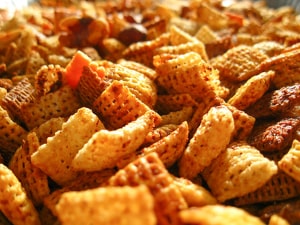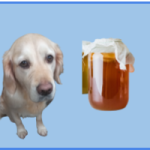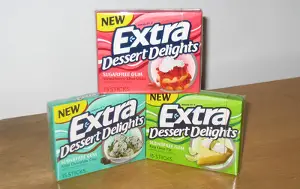
It’s party time!
No matter if that means firing up the BBQ on July 4th or lighting the open fire on New Year’s Eve, there are a few things you can guarantee.
A guest list as long as your arm, lots of alcohol and bowls of Chex mix.
That’s right, you’ve guessed it.
No matter what the occasion for every one there is a special blend of Chex mix.
And in this article I want to talk about how dog friendly these snacks are.
If they are that sensational, can you dog eat Chex mix?
For starters, let me look at just how many varieties of this snack there is.
What is Chex mix?
Chex mix is a snack food that uses a chex breakfast cereal as its base and then adds other foods (such as nuts, pretzels or other cereals) into the bowl to create a mix.
The original Wheat Chex cereal was launched in 1937 and Rice Chex appeared in 1950.
It was in 1952 that the original Chex mix was born with a recipe in Life magazine.
But things have come a long way since.
Let me show you what I mean and how difficult it is to provide a detailed answer about whether your dog can eat them.
To add to the Wheat and Rice Chex, there are now seven other Chex cereals.
- Corn
- Chocolate
- Cinnamon
- Peanut Butter
- Blueberry
- Honey Nut
- Vanilla
Giving a dizzy total of nine.
To make things even more confusing, on the cereal’s website there are seventy four different chex mix recipes for people to make- ranging from the original Chex mix to a Caramel, peanut and popcorn mix to a Christmas Chex mix.
Packets of Chex Mix
You can buy ready to eat Chex mix.
And there are fourteen of these:
- Traditional
- Cheddar
- Bold
- Max’d Buffalo Ranch
- Max’d Spicy Dill
- Honey BBQ
- Sour Cream & Onion
- Turtle
- Trail Mix
- Dark Chocolate
- Jalapeno Cheddar
- Hot & Spicy
- Ghost Pepper
- Honey Nut
In addition, there is a smaller range of five chocolate based Chex Mixes, called Muddy Buddies:
- Brownie Supreme
- Cookies & Cream
- Mint Chocolate
- Peanut Butter & Chocolate
- Snickerdoodle
So, first I will focus on the standard Chex mixes and then I will take a look at the Muddy Buddy range.
But before I do that, I want to talk a little about why a dog might eat Chex mix in the first place.
Why is my dog eating Chex mix?
To me there are two main reasons for this.
Firstly, it is because a guilty feeling dog parent feeds them a bit here and a bit there of Chex mix.
And we all do it at some point or another.
That little nagging voice in our head as we snack on something.
The voice that tells us that it is unfair that we get to snack and our dogs don’t.
Our dog is sitting next to us (of course) and a little bit of this won’t harm them, will it?
And the second big reason that dogs eat Chex Mix is because they are “hosts” at a party where there are random bowls of Chex mix dotted around.
And well, you know how it is?
Everyone is having a great time- there is plenty to eat and even more to drink.
And nobody is checking on the dog, who is just helping themselves!
So now that I have set the scene, so to speak, let’s see how much trouble this “secret snacker” could be in…
Can my dog eat standard Chex mixes?
It seems that no matter what the different flavours are, the main ingredients are the same.
So your dog could have eaten some Cheddar Chex Mix or some Ghost Pepper Chex Mix but the majority of the ingredients are exactly the same.
When we look at a list of ingredients on a food packet, the most commonly used ingredients are listed first.
And the main ingredients in any standard Chex Mix are:
- Whole Wheat
- Degermed Yellow Corn Meal
- Enriched Flour
- Vegetable Oil
- Sugar
- Rye flour
- Whey Flour
None of these ingredients are toxic or poisonous to your dog- unless your dog is one of the few who has a gluten intolerance.
In which case the whole wheat will cause them trouble.
Have you come across degermed yellow corn meal before?
Don’t worry if you haven’t- neither have I.
Degermed yellow corn meal is ground corn that has had all the nutrition taken out.
It is nothing for your dog to worry about.
There is an ingredient which isn’t on the list and which we can only find by looking at the nutrition label.
An example of the nutrition label can be seen on the right of the page.
The sodium (or salt to you and I) levels in these mixes is sky high.
A 30g serving of this mix contains 10% of the recommended intake of salt for an adult.
And 30g isn’t much more than a handful.
Dogs need sodium in their diet.
But the calculation for dogs is done a bit differently for dogs.
And the organisation in charge of deciding what should be in dog food, recommend that at least .3% of their diet should be salt.
Let me use one of my Golden Retrievers as an example.
Sylvie eats 500g of wet food per day.
.3% of 500 is 1.5 g of salt per day.
A 30 g serving of any Chex mix provides 230 mg of salt- we can see that from the nutrition label.
A 180 g serving of Chex mix would provide the minimum level of salt that my dog should eat per day.
And these mix bags weigh 240 g- which is the equivalent of her eating most of one of these big bags.
Having looked at most of the biggest ingredients, in the standard range of Chex mixes, I want to highlight two specific ingredients- spices and chocolate.
You won’t find specific spices mentioned in the ingredients list but I more generally wanted to talk about feeding your dog spicy foods.
As far as chocolate goes, it is an ingredient in a couple of the Chex mixes from the standard range (Dark Chocolate and Turtle) but I will lump that in with a discussion I want to have about the Muddy Buddy range.
Should we feed dogs spicy food?
Well in the standard range there are five spice mixes:
- Maxd Buffalo Range
- Max’d Spicy Dill
- Hot and Spicy
- Jalopeno Cheddar
- Ghost Pepper
As I have said, it is difficult to measure how spicy each of these flavours is partly because the listed ingredients are so vague.
But how do dogs react to spices? Do spices cause dogs any discomfort, are they toxic to dogs or do dogs not even taste spices?
Many of us know that a dog has an amazing sense of smell but fewer people know that a dog’s sense of taste is pretty poor.
Let me explain myself a bit more with the help of some numbers.
It is thought that a dog’s sense of smell is a million times stronger than a human’s sense of smell.
But, when it comes to taste, “the shoe is on the other foot”.
Whereas people have about nine thousand taste buds, dogs have around 1700.
What scientists do know is that dogs can taste four main flavours- sweet, salty, bitter and sour.
But just because they have far fewer taste buds, doesn’t mean that they taste everything poorly.
For example, it is believed that dogs can taste far more flavours in water than humans do.
But what does this all mean for dogs and spices?
Well, I think that if a dog eats spicy food then it won’t taste as spicy to them as it would to us.
But wait up!
Before you go adding a few chillies into your next meal, taste is only one of the unpleasant consequences of eating spicy foods.
Another consequence could be diarrhea.
And I don’t want to delve too deeply into this subject (if you want to then you can read about it here.)
But essentially, even though your dog might not be burned by the taste, their digestive system might be turned upside by the ingredients.)
To summarise all of this, I would either keep the spicy flavours from the Chex mix range well away from your dog or feed them to them in very, very limited quantities.
Having gone into lots of detail about how appropriate it is for your dog to eat packs of Chex mix from their standard range, I will now look at their Muddy Buddy range.
Can dogs eat Muddy Buddy Chex mix?
Did you know that the average European eats as much chocolate as seafood?
That is a great fact, isn’t it?
Americans eat about half as much chocolate as Europeans but they still consume an average of eleven pounds of the stuff.
Little wonder then that Chex mix wanted a piece of the pie.
There are five different flavours in the chocolate based Muddy Buddy range:
- Brownie Supreme
- Cookies and Cream
- Mint Chocolate
- Peanut Butter and Chocolate and
- Snickerdoodle
In addition there are two chocolate flavours in the standard Chex mix range- Turtle and Dark Chocolate.
Most chocolate is poisonous to dogs because any chocolate with cocoa in it has a chemical called theobromine that dog’s cannot absorb and process.
Instead of it dissolving harmlessly in a dog’s body, it causes irregular heart beats and seizures.
The darker the chocolate or the purer the cocoa powder the more toxic it is.
And smaller dogs are more at risk than larger dogs.
Personally, I wouldn’t feed any Chex mix with chocolate in it to my dog.
And this is because cocoa is mentioned as one of the main ingredients in many of these packs.
It listed in the following packs:
- Brownie Supreme
- Mint Chocolate
- Peanut Butter and Chocolate
Now, we don’t know any exact amounts (because we never do) but we know that it is more than 2% of the total ingredients.
The other chocolate themed packs of Chex mix (Turtle, Cookies and Cream and Snickerdoodle) mention cocoa but only as a sub ingredient of a “confectionary mix” or “candy pieces.”)
And this includes the dark chocolate pack as well- which is strange because I would have thought that this pack, in name alone, was the biggest threat to a dog.
So, as I said, play it safe and make sure that your dog doesn’t get any sneaky bites from any Chex mix with chocolate in them.





